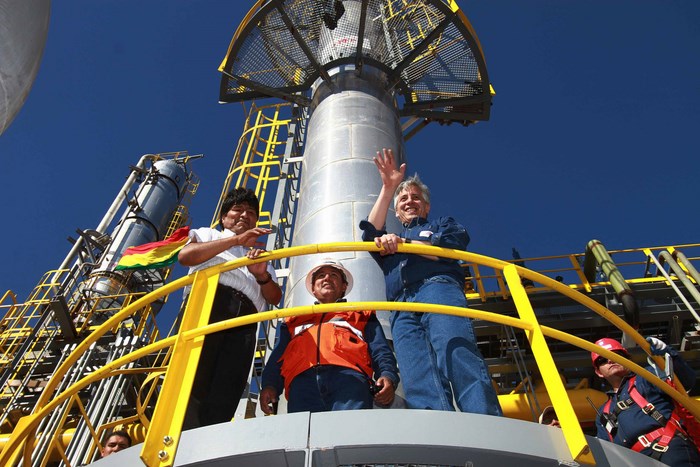Joel Michel Varona
The nationalization of the
hydrocarbons in Bolivia has not only changed the
course of the South American nation’s history, but
in the last eight years, has also made this sector
the steam engine of the national economy. Since the
start of the process, the government and energy
sector have implemented various programs such as the
National Development Plan, the Bolivian Hydrocarbon
Strategy, Plans for Investment, Exploration,
Industrialization, as well as the Hydrocarbon
Agenda.
 In
Bolivia hydrocarbons were returned to the people,
thanks to the government of Evo Morales (far left),
next to Álvaro García, vice president of Bolivia (far
right) in the natural gas liquids separation plant
in Río Grande, which produces Liquefied Petroleum
Gas (GLP) and stabilized gas.
In
Bolivia hydrocarbons were returned to the people,
thanks to the government of Evo Morales (far left),
next to Álvaro García, vice president of Bolivia (far
right) in the natural gas liquids separation plant
in Río Grande, which produces Liquefied Petroleum
Gas (GLP) and stabilized gas.
The nationalization through state
owned Treasury Oil Fields Bolivia (YPFB) generated a
boom for the country. The encouraging results led to
an investment of just over 3 billion dollars, a
record amount in the history of the national
industry.
This process of investment benefits
areas such as exploration, exploitation, storage,
refining, transportation, separation plans,
industrialization, gas networks, commercialization
and smaller investments.
On May 1, 2006, President of
Bolivia, Evo Morales, decreed the nationalization of
the hydrocarbons sector, a decision which, according
to the president of the YPFB, Carlos Villegas, was
fundamental, as it saved the business from
extinction and transformed it into the most
important company in Bolivia.
 Carlos
Villegas, president of YPFB, said that the decision
to nationalize the hydrocarbons sector in Bolivia
was fundamental to rescuing the company from
extinction and transforming it in to the most
important business in Bolivia.
Carlos
Villegas, president of YPFB, said that the decision
to nationalize the hydrocarbons sector in Bolivia
was fundamental to rescuing the company from
extinction and transforming it in to the most
important business in Bolivia.
Villegas recalled that due to
decisions taken by Bolivian governments associated
with United States interests, focused on
privatization of public companies, the YPFB was
languishing in the liquidation process.
It has been eight years since the
sector was nationalized, a politically, economically
and socially vital decision by Evo Morales. The 4th
International Gas and Oil Congress, organized by the
YPFB was recently held in the western city of Santa
Cruz de la Sierra, Bolivia, to which experts,
executives and authorities in the field of
hydrocarbons, attended.
Among the companies participating
were the Russian Gazprom, YPF from Argentina, Pdvsa
from Venezuela, Ecuadorian Petroamazonas, Petrobras
from Brazil and the Chinese National Petroleum
Corporation Company. During the event it was
announced that the Bolivian Liquefied Petroleum Gas
(GLP) industry is forecast to produce 1,400 tons of
gas per day as of January 2015, which will enable
the country meet its domestic needs and consolidate
an export plan in Latin America.
 The
hydrocarbon industry is the most important sector of
the Bolivian economy, with taxes and royalties.
The
hydrocarbon industry is the most important sector of
the Bolivian economy, with taxes and royalties.
According to Patricio Norris,
director of the GLP Business Development Group of
the Dutch company Trafigura, Bolivia is on track to
lead the gas industry in Latin America. He commented
that in order to strengthen the sector the country
must consider regional markets, since lower
transportation costs would mean greater earnings.
Norris explained that Brazil will
shortly achieve self-sufficiency, but won’t have
surplus to export, while Chile, Paraguay and Uruguay
must overcome various differences to produce GLP on
a large scale. One of the main proposals of the 4th
International Gas and Oil Congress was to create a
block of hydrocarbon producing Latin American
countries in order to increase cooperation in this
field.
During his speech, Miguel Matías
Galuccio, president of Treasury Oil Fields
Argentina, stated that they are planning to create a
congress – called G-10 - which will bring together
the major hydrocarbon powers in Latin America.
He commented that he believes there
is potential among the companies the YPFA works with
in Latin America, which is still not fully exploited,
also highlighting that Latin America is a conflict-free
zone, a continent with shared histories and
integration, as much economic as cultural. He
continued, emphasizing the many existent links in
the field of energy shared by Latin American nations
- pipelines for example which cross countries and
jointly operated power plants. He emphasized that if
the initiative is successful, next year they will
begin to develop the first G-10 hydrocarbon powers
congress.
The 4th International Gas and Oil Congress held over
two days in Santa Cruz is considered to be the most
important in this field within the region. (PL)